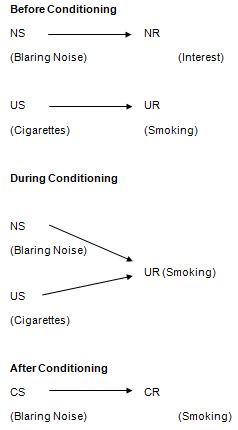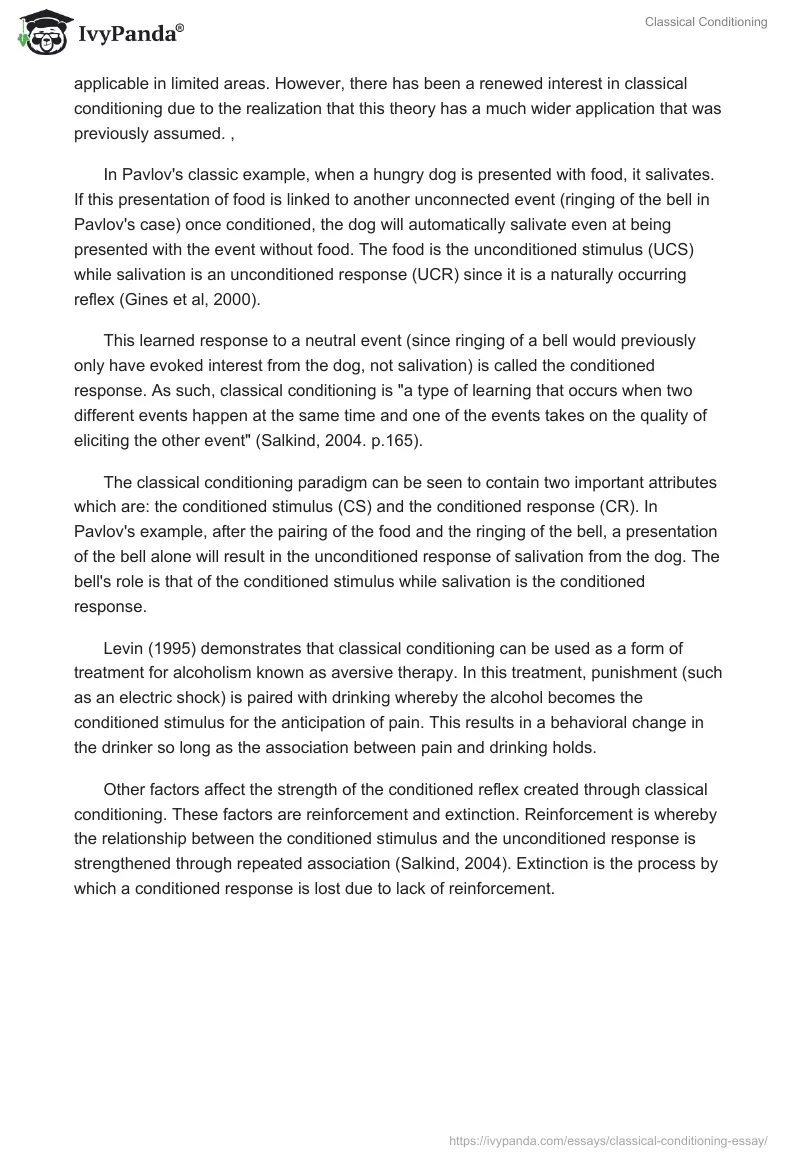Introduction
Learning, which is defined as the process of human beings gaining knowledge and expertise is an important aspect of man’s life and continues throughout his existence. Learning theories propose mechanisms that account for the changes that occur as a result of our learning experiences.
Learning theories have resulted in the identification of mechanisms through which experiences in the environment would alter and sustain changes in behavior. These changes are of a relatively permanent nature, and Newman and Philip (2007) affirm that the changes in human behavior are as a result of human beings’ extensive capacity for learning.
Classical conditioning is one of the most popular learning theories developed in the late 1920s. This theory has been reviewed and applied in many areas and has helped in understanding learning. This paper will give a brief description of the theory of classical conditioning and how it works. A scenario whereby this theory could be applied in real life situations will be given and a detailed description of how one would implement classical conditioning demonstrated.
Describe the theory of classical conditioning
The Russian Scientist, Ivan Pavlov, is hugely credited for coming up with the classical conditioning theory and demonstrating its working. Pavlov’s experimental works led him to discover classical conditioning and its laws which he demonstrated using his famous Pavlov’s dog experiment. By definition, classical conditioning is the “pairing of an unconditioned stimulus with a conditioned stimulus to produce a conditioned response” (Levin, 1995, p.175).
In classical conditioning, there is already a preexisting bond between the stimulus and some physiological response in the learner. Classical conditioning has since its formulation been overlooked as being fairly simple and easy to understand and only applicable in limited areas. However, there has been a renewed interest in classical conditioning due to the realization that this theory has a much wider application that was previously assumed. ,
In Pavlov’s classic example, when a hungry dog is presented with food, it salivates. If this presentation of food is linked to another unconnected event (ringing of the bell in Pavlov’s case) once conditioned, the dog will automatically salivate even at being presented with the event without food. The food is the unconditioned stimulus (UCS) while salivation is an unconditioned response (UCR) since it is a naturally occurring reflex (Gines et al, 2000).
This learned response to a neutral event (since ringing of a bell would previously only have evoked interest from the dog, not salivation) is called the conditioned response. As such, classical conditioning is “a type of learning that occurs when two different events happen at the same time and one of the events takes on the quality of eliciting the other event” (Salkind, 2004. p.165).
The classical conditioning paradigm can be seen to contain two important attributes which are: the conditioned stimulus (CS) and the conditioned response (CR). In Pavlov’s example, after the pairing of the food and the ringing of the bell, a presentation of the bell alone will result in the unconditioned response of salivation from the dog. The bell’s role is that of the conditioned stimulus while salivation is the conditioned response.
Levin (1995) demonstrates that classical conditioning can be used as a form of treatment for alcoholism known as aversive therapy. In this treatment, punishment (such as an electric shock) is paired with drinking whereby the alcohol becomes the conditioned stimulus for the anticipation of pain. This results in a behavioral change in the drinker so long as the association between pain and drinking holds.
Other factors affect the strength of the conditioned reflex created through classical conditioning. These factors are reinforcement and extinction. Reinforcement is whereby the relationship between the conditioned stimulus and the unconditioned response is strengthened through repeated association (Salkind, 2004). Extinction is the process by which a conditioned response is lost due to lack of reinforcement.
Scenario for Classical Conditioning Application
As has been illustrated in the above paragraphs, classical conditioning theory can be used to help someone learn or unlearn a habit. In my specific situation, I aim to use classical conditioning to make a friend unlearn a habit I find unacceptable in my house.
My friend always smokes in my living room despite my numerous calls for him to stop this habit. I propose to use classical conditioning theory to train my friend to stop smoking in my house altogether by making him associate smoking to an unpleasant blaring noise.
Implementation
Before conditioning, the irritating blaring sound is a neutral stimulus. Newman and Philip (2007) note that such a stimulus on its own elicits a response of interest or attention but nothing more. Cigarettes are an unconditioned stimulus that evokes a natural reaction resulting in smoking from my friend.
My classical conditioning implementation will, therefore, involve pairing the irritating blaring music with smoking. As such, cigarettes will become the conditioned stimulus for the anticipation of an irritating noise whenever my friend is in my house. For this to work, I will have to make my friend associate two different events (smoking and the blaring sounds) with each other.
I shall, therefore, ensure that each time my friend starts smoking in my house, I shall turn the irritating blaring sounds on. Once my friend has finished smoking, I shall turn to noises off. Newman and Philip (2007) assert that a conditioned response is only established to the degree that there is a meaningful relationship between the neutral stimulus and the unconditioned stimulus.
This means that the NS and US must occur together many times before conditioning is established. For this reason, I shall make sure that I continue will this activity (turning on the blaring noise as soon as smoking begins) indefinitely.
Results
With repeated association of the NS (blaring noise) and the US (cigarettes), the blaring noise will become a conditioned stimulus and will be associated with smoking, which will now become the conditioned response.
As such, my friend will relate cigarette smoking in my house to loud irritating noises, and for this reason, he will stop smoking to avoid experiencing the irritating noises which he will have grown to associate with cigarettes. To avoid this conditioning from becoming extinct, I would keep on reinforcing the relationship between the blaring noise and smoking so as to strengthen the association in my friend.
References
Gines, Et AL. (2000). Educational Psychology. Rex Bookstore.
Levin, D. L. (1995). Introduction to Alcoholism Counseling: a Bio-Psycho-Social Approach. Taylor & Francis.
Newman, B. M. Philip, R. N. (2007). Theories of Human Development. Routledge.
Salkind, J. N. (2004). An Introduction to Theories of Human Development. Sage.
Conditioning Chart

- NS = Neutral Stimulus
- UR = Unconditioned Response
- NR = Neutral Response
- CS = Conditioned Stimulus
- US = Unconditioned Stimulus
- CR = Conditioned Response


